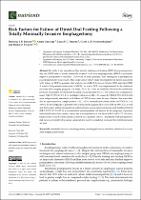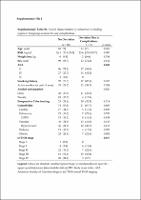| dc.contributor | Vall d'Hebron Barcelona Hospital Campus |
| dc.contributor.author | Janssen, Henricus J. B. |
| dc.contributor.author | Gantxegi Madina, Amaia |
| dc.contributor.author | Fransen, Laura F. C. |
| dc.contributor.author | Nieuwenhuijzen, Grard A. P. |
| dc.contributor.author | Luyer, Misha D. P. |
| dc.date.accessioned | 2022-05-06T12:55:27Z |
| dc.date.available | 2022-05-06T12:55:27Z |
| dc.date.issued | 2021-10 |
| dc.identifier.citation | Janssen HJB, Gantxegi A, Fransen LFC, Nieuwenhuijzen GAP, Luyer MDP. Risk Factors for Failure of Direct Oral Feeding Following a Totally Minimally Invasive Esophagectomy. Nutrients. 2021 Oct;13(10):3616. |
| dc.identifier.issn | 2072-6643 |
| dc.identifier.uri | https://hdl.handle.net/11351/7493 |
| dc.description | Esophageal cancer; Jejunostomy; Nutrition |
| dc.description.abstract | Recently, it has been shown that directly starting oral feeding (DOF) from postoperative day one (POD1) after a totally minimally invasive Ivor-Lewis esophagectomy (MIE-IL) can further improve postoperative outcomes. However, in some patients, tube feeding by a preemptively placed jejunostomy is necessary. This single-center cohort study investigated risk factors associated with failure of DOF in patients that underwent a MIE-IL between October 2015 and April 2021. A total of 165 patients underwent a MIE-IL, in which DOF was implemented in the enhanced recovery after surgery program. Of these, 70.3% (n = 116) successfully followed the nutritional protocol. In patients in which tube feeding was needed (29.7%; n = 49), female sex (compared to male) (OR 3.5 (95% CI 1.5–8.1)) and higher ASA scores (III + IV versus II) (OR 2.2 (95% CI 1.0–4.8)) were independently associated with failure of DOF for any cause. In case of failure, this was either due to a postoperative complication (n = 31, 18.8%) or insufficient caloric intake on POD5 (n = 18, 10.9%). In the subgroup of patients with complications, higher ASA scores (OR 2.8 (95% CI 1.2–6.8)) and histological subtypes (squamous-cell carcinoma versus adenocarcinoma and undifferentiated) (OR 5.2 (95% CI 1.8–15.1)) were identified as independent risk factors. In the subgroup of patients with insufficient caloric intake, female sex was identified as a risk factor (OR 5.8 (95% CI 2.0–16.8)). Jejunostomy-related complications occurred in 17 patients (10.3%). In patients with preoperative risk factors, preemptively placing a jejunostomy may be considered to ensure that nutritional goals are met. |
| dc.language.iso | eng |
| dc.publisher | MDPI |
| dc.relation.ispartofseries | Nutrients;13(10) |
| dc.rights | Attribution 4.0 International |
| dc.rights.uri | http://creativecommons.org/licenses/by/4.0/ |
| dc.source | Scientia |
| dc.subject | Esòfag - Cirurgia - Complicacions |
| dc.subject | Cirurgia endoscòpica |
| dc.subject | Alimentació |
| dc.subject.mesh | Esophagectomy |
| dc.subject.mesh | /adverse effects |
| dc.subject.mesh | Minimally Invasive Surgical Procedures |
| dc.subject.mesh | Eating |
| dc.title | Risk Factors for Failure of Direct Oral Feeding Following a Totally Minimally Invasive Esophagectomy |
| dc.type | info:eu-repo/semantics/article |
| dc.identifier.doi | 10.3390/nu13103616 |
| dc.subject.decs | esofagectomía |
| dc.subject.decs | /efectos adversos |
| dc.subject.decs | procedimientos quirúrgicos mínimamente invasivos |
| dc.subject.decs | ingestión de alimentos |
| dc.relation.publishversion | https://doi.org/10.3390/nu13103616 |
| dc.type.version | info:eu-repo/semantics/publishedVersion |
| dc.audience | Professionals |
| dc.contributor.organismes | Institut Català de la Salut |
| dc.contributor.authoraffiliation | [Janssen HJB, Fransen LFC, Nieuwenhuijzen GAP, Luyer MDP] Department of Surgery, Catharina Hospital, 5602ZA Eindhoven, The Netherlands. [Gantxegi A] Servei de Cirurgia, Vall d’Hebron Hospital Universitari, Barcelona, Spain. Universitat Autònoma de Barcelona, Bellaterra, Spain |
| dc.identifier.pmid | 34684617 |
| dc.identifier.wos | 000715144200001 |
| dc.rights.accessrights | info:eu-repo/semantics/openAccess |


